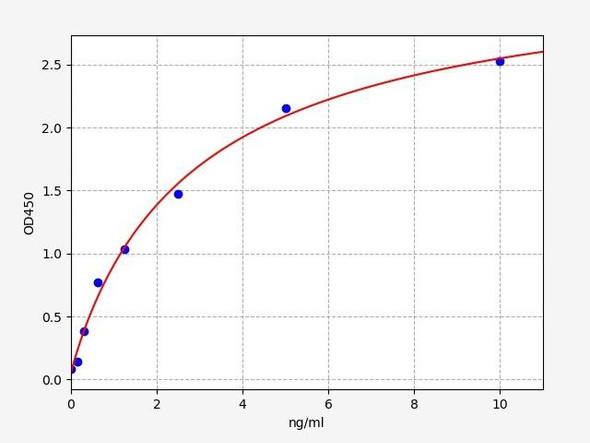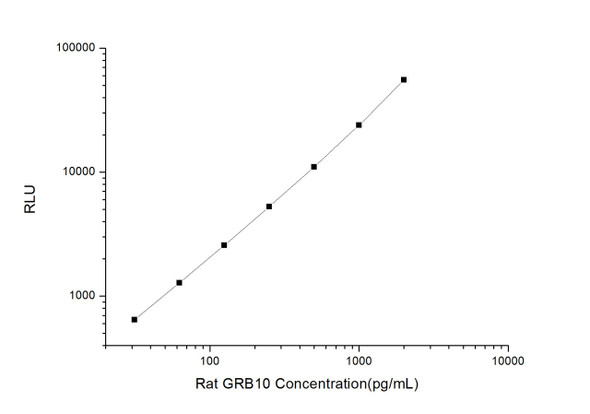Rat Signaling ELISA Kits 3
Rat GRB14 (Growth Factor Receptor Bound Protein 14) CLIA Kit (RTES00271)
- SKU:
- RTES00271
- Product Type:
- ELISA Kit
- ELISA Type:
- CLIA Kit
- Size:
- 96 Assays
- Sensitivity:
- 18.75pg/mL
- Range:
- 31.25-2000pg/mL
- ELISA Type:
- Sandwich
- Reactivity:
- Rat
- Sample Type:
- Serum, plasma and other biological fluids
Description
| Assay type: | Sandwich |
| Format: | 96T |
| Assay time: | 4.5h |
| Reactivity: | Rat |
| Detection method: | Chemiluminescence |
| Detection range: | 31.25-2000 pg/mL |
| Sensitivity: | 18.75 pg/mL |
| Sample volume: | 100µL |
| Sample type: | Serum, plasma and other biological fluids |
| Repeatability: | CV < 15% |
| Specificity: | This kit recognizes Rat GRB14 in samples. No significant cross-reactivity or interference between Rat GRB14 and analogues was observed. |
This kit uses Sandwich-CLIA as the method. The micro CLIA plate provided in this kit has been pre-coated with an antibody specific to Rat GRB14. Standards or samples are added to the appropriate micro CLIA plate wells and combined with the specific antibody. Then a biotinylated detection antibody specific for Rat GRB14 and Avidin-Horseradish Peroxidase (HRP) conjugate are added to each micro plate well successively and incubated. Free components are washed away. The substrate solution is added to each well. Only those wells that contain Rat GRB14, biotinylated detection antibody and Avidin-HRP conjugate will appear fluorescence. The Relative light unit (RLU) value is measured spectrophotometrically by the Chemiluminescence immunoassay analyzer. The RLU value is positively associated with the concentration of Rat GRB14. The concentration of Rat GRB14 in the samples can be calculated by comparing the RLU of the samples to the standard curve.
| UniProt Protein Function: | GRB14: Adapter protein which modulates coupling of cell surface receptor kinases with specific signaling pathways. Binds to, and suppresses signals from, the activated insulin receptor (INSR). Potent inhibitor of insulin-stimulated MAPK3 phosphorylation. Plays a critical role regulating PDPK1 membrane translocation in response to insulin stimulation and serves as an adapter protein to recruit PDPK1 to activated insulin receptor, thus promoting PKB/AKT1 phosphorylation and transduction of the insulin signal. Belongs to the GRB7/10/14 family. |
| UniProt Protein Details: | Protein type:Adaptor/scaffold Chromosomal Location of Human Ortholog: 3q21 Cellular Component: cytoplasm; endosome; Golgi apparatus; intracellular membrane-bound organelle; plasma membrane Molecular Function:phosphoprotein binding; protein binding; SH3/SH2 adaptor activity Biological Process: insulin receptor signaling pathway; negative regulation of insulin receptor signaling pathway |
| NCBI Summary: | member of the Grb7 subfamily of adapters; functions as inhibitor in insulin-mediated pathways [RGD, Feb 2006] |
| UniProt Code: | O88900 |
| NCBI GenInfo Identifier: | 13928858 |
| NCBI Gene ID: | 58844 |
| NCBI Accession: | NP_113811. 1 |
| UniProt Related Accession: | O88900 |
| Molecular Weight: | 34. 6kDa |
| NCBI Full Name: | growth factor receptor-bound protein 14 |
| NCBI Synonym Full Names: | growth factor receptor bound protein 14 |
| NCBI Official Symbol: | Grb14 |
| NCBI Protein Information: | growth factor receptor-bound protein 14 |
| UniProt Protein Name: | Growth factor receptor-bound protein 14 |
| UniProt Synonym Protein Names: | GRB14 adapter protein |
| Protein Family: | Growth factor receptor-bound protein |
| UniProt Gene Name: | Grb14 |
As the RLU values of the standard curve may vary according to the conditions of the actual assay performance (e. g. operator, pipetting technique, washing technique or temperature effects), the operator should establish a standard curve for each test. Typical standard curve and data is provided below for reference only.
| Concentration (pg/mL) | RLU | Average | Corrected |
| 2000 | 54381 57061 | 55721 | 55693 |
| 1000 | 23294 24654 | 23974 | 23946 |
| 500 | 11236 10828 | 11032 | 11004 |
| 250 | 5090 5498 | 5294 | 5266 |
| 125 | 2614 2602 | 2608 | 2580 |
| 62.5 | 1400 1222 | 1311 | 1283 |
| 31.25 | 651 697 | 674 | 646 |
| 0 | 27 29 | 28 | -- |
Precision
Intra-assay Precision (Precision within an assay): 3 samples with low, mid range and high level Rat GRB14 were tested 20 times on one plate, respectively.
Inter-assay Precision (Precision between assays): 3 samples with low, mid range and high level Rat GRB14 were tested on 3 different plates, 20 replicates in each plate.
| Intra-assay Precision | Inter-assay Precision | |||||
| Sample | 1 | 2 | 3 | 1 | 2 | 3 |
| n | 20 | 20 | 20 | 20 | 20 | 20 |
| Mean (pg/mL) | 106.56 | 265.80 | 967.63 | 100.60 | 240.13 | 990.77 |
| Standard deviation | 9.14 | 21.42 | 89.51 | 11.96 | 18.03 | 84.12 |
| C V (%) | 8.58 | 8.06 | 9.25 | 11.89 | 7.51 | 8.49 |
Recovery
The recovery of Rat GRB14 spiked at three different levels in samples throughout the range of the assay was evaluated in various matrices.
| Sample Type | Range (%) | Average Recovery (%) |
| Serum (n=5) | 88-104 | 95 |
| EDTA plasma (n=5) | 96-112 | 102 |
| Cell culture media (n=5) | 86-99 | 91 |
Linearity
Samples were spiked with high concentrations of Rat GRB14 and diluted with Reference Standard & Sample Diluent to produce samples with values within the range of the assay.
| Serum (n=5) | EDTA plasma (n=5) | Cell culture media (n=5) | ||
| 1:2 | Range (%) | 98-109 | 101-120 | 100-114 |
| Average (%) | 104 | 109 | 108 | |
| 1:4 | Range (%) | 99-115 | 96-111 | 90-103 |
| Average (%) | 105 | 103 | 95 | |
| 1:8 | Range (%) | 100-117 | 84-98 | 90-103 |
| Average (%) | 109 | 91 | 96 | |
| 1:16 | Range (%) | 94-104 | 98-114 | 104-119 |
| Average (%) | 99 | 105 | 110 |
An unopened kit can be stored at 4°C for 1 month. If the kit is not used within 1 month, store the items separately according to the following conditions once the kit is received.
| Item | Specifications | Storage |
| Micro CLIA Plate(Dismountable) | 8 wells ×12 strips | -20°C, 6 months |
| Reference Standard | 2 vials | |
| Concentrated Biotinylated Detection Ab (100×) | 1 vial, 120 µL | |
| Concentrated HRP Conjugate (100×) | 1 vial, 120 µL | -20°C(shading light), 6 months |
| Reference Standard & Sample Diluent | 1 vial, 20 mL | 4°C, 6 months |
| Biotinylated Detection Ab Diluent | 1 vial, 14 mL | |
| HRP Conjugate Diluent | 1 vial, 14 mL | |
| Concentrated Wash Buffer (25×) | 1 vial, 30 mL | |
| Substrate Reagent A | 1 vial, 5 mL | 4°C (shading light) |
| Substrate Reagent B | 1 vial, 5 mL | 4°C (shading light) |
| Plate Sealer | 5 pieces | |
| Product Description | 1 copy | |
| Certificate of Analysis | 1 copy |
- Set standard, test sample and control (zero) wells on the pre-coated plate and record theirpositions. It is recommended to measure each standard and sample in duplicate. Note: addall solutions to the bottom of the plate wells while avoiding contact with the well walls. Ensuresolutions do not foam when adding to the wells.
- Aliquot 100µl of standard solutions into the standard wells.
- Add 100µl of Sample / Standard dilution buffer into the control (zero) well.
- Add 100µl of properly diluted sample (serum, plasma, tissue homogenates and otherbiological fluids. ) into test sample wells.
- Cover the plate with the sealer provided in the kit and incubate for 90 min at 37°C.
- Aspirate the liquid from each well, do not wash. Immediately add 100µL of BiotinylatedDetection Ab working solution to each well. Cover the plate with a plate seal and gently mix. Incubate for 1 hour at 37°C.
- Aspirate or decant the solution from the plate and add 350µL of wash buffer to each welland incubate for 1-2 minutes at room temperature. Aspirate the solution from each well andclap the plate on absorbent filter paper to dry. Repeat this process 3 times. Note: a microplatewasher can be used in this step and other wash steps.
- Add 100µL of HRP Conjugate working solution to each well. Cover with a plate seal andincubate for 30 min at 37°C.
- Aspirate or decant the solution from each well. Repeat the wash process for five times asconducted in step 7.
- Add 100µL of Substrate mixture solution to each well. Cover with a new plate seal andincubate for no more than 5 min at 37°C. Protect the plate from light.
- Determine the RLU value of each well immediately.






